Well, knowing these 2024 food trends will help you stay ahead of the curve, impress your family and friends, and most importantly, have fun while exploring new flavors and techniques. Interested to find out what food or foods are growing in popularity this year?
Well, keep on reading! In this article, we’ll dive into some of the top food trends of 2024 that are shaping the culinary landscape. You never know, you might be able to incorporate these trends into your own home cooking and food-selling adventures!
Top Food Trends in 2024 # 1: Mood-Boosting Foods

According to UpMenu.com, mood-boosting foods are gaining popularity as more people recognize the direct link between nutrition and mental well-being. These foods contain nutrients that support brain health and help maintain emotional balance.
In addition to enhancing mood, these foods can improve memory and focus, giving you the energy to get through your day. Wondering what these foods are, exactly?
Here are some excellent mood-boosting ingredients you can start using in your recipes:
- Dark chocolate: Considered as a superfood, dark chocolates stimulate the production of endorphins, the brain’s natural feel-good chemicals, and provide magnesium, a mineral known to combat stress and anxiety. We talk about this and about other chocolates in this article.
- Berries: Strawberries, blueberries, and raspberries are packed with antioxidants and can help reduce stress. The anthocyanins and polyphenols found in berries have been linked to mood improvement.
- Nuts and seeds: Almonds, walnuts, and chia seeds are examples of nuts and seeds that are rich in plant-based protein, healthy fats, fiber, and nutrients that support brain health.
- Fish: Salmon and other fatty fish contain omega-3 fatty acids, which are great for your brain and mood.
- Whole grains: Oats, brown rice, and whole wheat bread can help regulate mood and are rich in B vitamins, which are known, again, for boosting both energy and mood.
Speaking of mood-boosting, one cuisine you should check out is Mediterranean cuisine. That’s because It features fresh, nutrient-dense ingredients like olive oil, fish, nuts, and plenty of fruits and vegetables, all known for their positive effects on mental well-being.
Top Food Trends in 2024 # 2: Personalized Nutrition
Personalized nutrition is another trend on the rise this 2024. According to KHNI, scientific evidence shows that our physiological and health needs vary based on factors like age, gender, and life stages. Consumers and scientists recognize that personalized approaches are more effective than general ones.
That is why there is an anticipated growing demand for food businesses specializing in personalized nutrition. Even as a home chef, you can still get in on the trend by creating delicious and healthy meals tailored to your family’s needs with these ideas:
- Build-your-own salad: Let everyone choose their own vegetables, proteins, and dressings.
- Customizable smoothies: Offer a variety of fruits, veggies, and add-ins like protein powder or yogurt.
- Individualized baked goods: Provide gluten-free, dairy-free, or low-sugar options, or even sugar-free options, such as those that Ms. Chiqui Dingcong provides in her classes.
Top Food Trends in 2024 # 3: Global Fusion
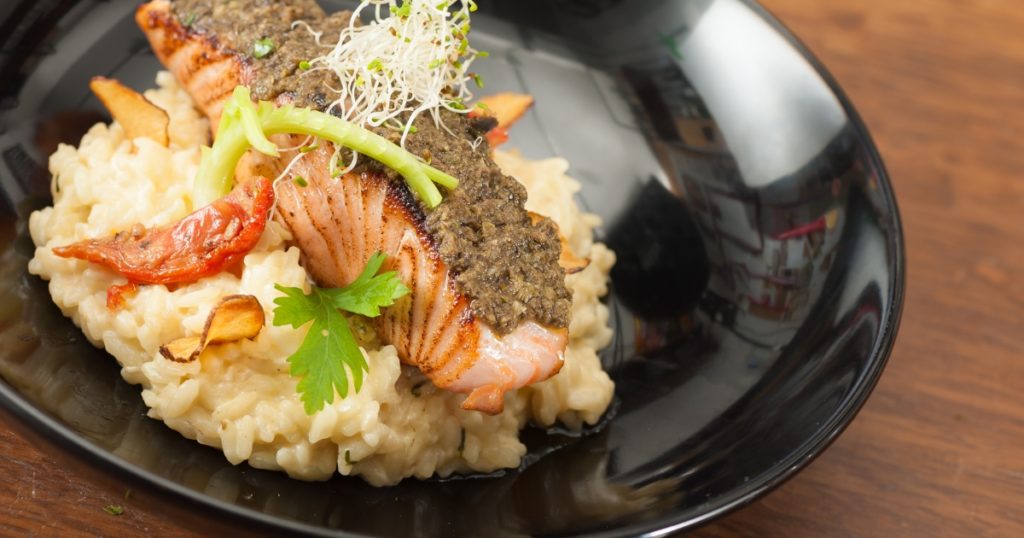
Global fusion cuisine combines elements from various international cuisines to create innovative and unique dishes, merging flavors, ingredients, and techniques from different cultures. This trend is popular because it allows for culinary exploration and reflects a growing appreciation for cultural diversity. It makes cooking more adventurous and helps people experience global flavors at home.
If you enjoy creating new dishes, global fusion is for you. It can be a fun adventure for your taste buds and helps you learn about different food practices around the world. Here are some examples of global fusion meals that you can try:
- Sushi burrito: Combine the flavors of Japanese sushi with the convenience of a Mexican burrito by wrapping sushi ingredients in a seaweed sheet and rice.
- Indian spiced burgers: Mix Indian spices like curry powder and garam masala into ground beef or chickpeas for a unique twist on traditional burgers
- Kimchi tacos: Fill tortillas with Korean kimchi, marinated beef or pork, and a hot sauce for a delicious fusion of Korean and Mexican flavors.
Oh and before we forget, Chef Him Uy De Baron, one of the instructors here at The Bailiwick Academy, has plenty of experience with global fusion. Check out his classes here to get a taste!
Top Food Trends in 2024 # 4: Zero-Waste Gastronomy

Zero-waste gastronomy is becoming a major trend in 2024 in the food and beverage industry, reflecting a growing commitment to sustainability and environmental responsibility in the culinary world. This approach is all about using every part of your ingredients to make sure nothing goes to waste.
Chefs and home cooks alike are embracing zero-waste techniques, from making stocks with vegetable scraps to creating flavorful dishes from overlooked parts of produce and proteins. This reduces waste and encourages innovation in the kitchen, leading to unique and resourceful recipes.
Want to get in on the trend? Here are some you can try:
- Vegetable scrap broth: Save your vegetable peels, stems, and ends to make a flavorful broth for soups and stews.
- Fruit peel jams: Turn your fruit peels and scraps into delicious homemade spreads, jams, and marmalades.
- Herb stems pesto: Use stems from herbs like parsley, cilantro, and basil to make a unique and flavorful pesto.
By adopting zero-waste gastronomy, you’re helping the planet and discovering new flavors and techniques to elevate your cooking. It’s a win-win for both your kitchen and the environment.
Top Food Trends in 2024 # 5: Culinary Storytelling
Culinary storytelling is another of the top food trends for 2024. No, this doesn’t necessarily involve food writers. Rather, it’s about chefs and restaurants using food and beverages to tell stories and connect with diners. This trend focuses on narratives, such as the origins of a recipe, ingredient sourcing, or the chef’s inspiration.
Diners are increasingly interested in the cultural context and personal touches that make each dish unique, which is why culinary storytelling is trending in the first place. This approach not only enhances their dining experience but also builds a stronger connection with the restaurant.
You don’t have to be a restaurant to embrace this trend, though. Even at home, you can share the stories behind your meals to create a more engaging and meaningful dining experience for your family.
Here are some approaches you can try:
- Family recipe night: Cook a meal using recipes that have been passed down through your family. Share the stories and memories that go along with each dish.
- Personal milestones: Prepare a dish that celebrates a significant moment in your life, like a birthday, anniversary, or other milestone. Share the emotions and memories associated with it.
- Travel-inspired dishes: Make a dish inspired by a place you’ve visited or dream of visiting. Share the story of why that place is special to you.
What is the next big food trend?
Here’s the thing about trends: food trends in 2024, for sure, will not be the same as food trends in 2025. It takes a lot of consumer insight to determine what they will be.
If you’re not looking to get into the food business, that’s okay! You can still try out these trends at home and enjoy experimenting and serving new things to your family.
But what if you do want to start a food business? Simply hopping on the biggest trends might work initially (like ube pandesal or burnt Basque cheesecake), but to ensure long-term success, you need something more sustainable.
Well, you don’t have to look too far; the answer is right here!
Join The Bailiwick Academy’s Food Business Bootcamp!
The TBA Food Business Bootcamp is a 14-week program that will give you the right foundation to build and sustain a successful food business.
Here are the modules you’ll get when you enroll:
- Entrepreneurial Mindset
- Soul Branding
- Branding 101
- Business Basics
- Menu Planning
- Human Resources
- Marketing and Sales
- Accounting
- Food Costing
- Legal Fundamentals
- Employment Law
- Business Planning
Plus, you get three bonus classes:
- Excel Basics for Food Business Owners
- Meat Processing Classes
- Mobile Food Photography
At the end of this, you’ll learn how to have a business that’s low-risk, low-maintenance, and high return of investment…
Even without necessarily paying attention to food trends in recent months.
So what are you waiting for?
Go to this page to learn more about the Food Business Bootcamp!
Oh, and of course, for you to officially join, sign up at The Bailiwick Academy. That way, you’ll get access to plenty of classes, too!
See you inside the boot camp or inside one of the TBA classes!
—
Keep coming back to The Bailiwick Academy blog for more kitchen tips, tricks, and much more!
]]>Whether you’re aiming to bake pizza yourself or simply love eating it, getting to know the various kinds is both fun and interesting. Let’s get started!
A Brief History of Pizza
What exactly is pizza? Well, pizza, like Torta Caprese, is from Italy. It is a round and flat, wheat-based dough topped with tomatoes, cheese, and other ingredients, and baked until the pizza crust is crispy and golden, and the cheese is bubbly and melted to perfection. But how exactly did it come to be?
According to Peatzeria, pizza evolved from flatbreads sold by street vendors in the late 18th century. The vendors topped with garlic, salt, herbs, lard, cheese, and other ingredients. They sold them primarily to low-paid workers seeking convenient and satisfying food.
Thankfully, in 1889 King Umberto I and Queen Margherita of Italy were impressed by a pizza topped with basil, mozzarella, and tomatoes, created by Raffaele Esposito to reflect the colors of the Italian flag. This pizza, known as the Margherita, gained royal approval. It also marked a significant moment in pizza history, making it go from street food to popular fare.
And in the 20th century, pizza gained popularity worldwide, especially in America. It became a favorite among Allied troops during World War II and later spread as Italians migrated to other countries and international travel became more common. This is also when different styles of pizza started popping up.
What are the different styles of pizza, exactly? Well, on to the main section of this article!
A Quick Disclaimer
This list doesn’t represent all different kinds of pizza. It’s just a taste of what we feel are some of the most popular and interesting kinds. We hope it gets you excited to try new pizzas and explore more on your own.
Here are some of the different kinds of pizzas you should make!
Different Kinds of Pizzas to Make 1: Margherita Pizza

Margherita pizza, a kind of tomato pizza, is one of the oldest flavors of pizza. It’s a classic Italian pizza composed of a thin crust topped with tomato sauce, fresh mozzarella cheese, basil leaves, a drizzle of olive oil, and a sprinkle of salt.
It’s simple, light, and possibly the purest form of pizza you’ll ever taste. Hey, it was approved by royalty, so it’s definitely good enough for all of us!
Different Kinds of Pizzas to Make 2: Pepperoni Pizza

Pepperoni pizza is one of the most popular pizzas in the United States—according to a 2017 Harris Poll, 36% of Americans prefer pepperoni on their pizza above all other toppings! It’s not hard to imagine why. The combination of a crispy crust, tangy tomato sauce, gooey mozzarella cheese, and the spicy kick of pepperoni slices creates a perfect balance of flavors and textures that many find irresistible.
The flavor appeal actually extends to the rest of the world. We’re sure you’d agree that pepperoni pizza is one of the most recognizable pizzas in the world.
Oh, and fun fact? Pepperoni pizza is not from Italy—this pizza is more of an Eastern European/American-Italian version.
Different Kinds of Pizzas to Make 3: Hawaiian Pizza

With all kinds of pizza toppings, how could anyone have thought of putting pineapple on pizza? Hawaiian pizza, which mixes sweet and savory tastes, is a bit of a debate starter. It usually has a thin crust with tomato sauce, mozzarella cheese, ham, and pineapple chunks.
Funny enough, the origin of this pizza is not from Hawaii—and there are conflicting origin stories. Some sources attribute the creation of Hawaiian pizza to Sam Panopoulos, a Greek immigrant in Canada. Supposedly, he added pineapple and ham or bacon to pizza at Satellite Restaurant in Chatham, Ontario in 1962.
Other evidence suggests that it was a pizzeria in Portland, Oregon where it all started. It was a store named Pizza Jungle that advertised a pizza with papaya, chopped green pepper, and pineapple as early as 1957, naming it the Hawaiian Pizza.
No matter the origin, this pizza is controversial. It’s popular with Americans, but we suggest never bringing this flavor up with Italians.
Different Kinds of Pizzas to Make 4: Neapolitan Pizza
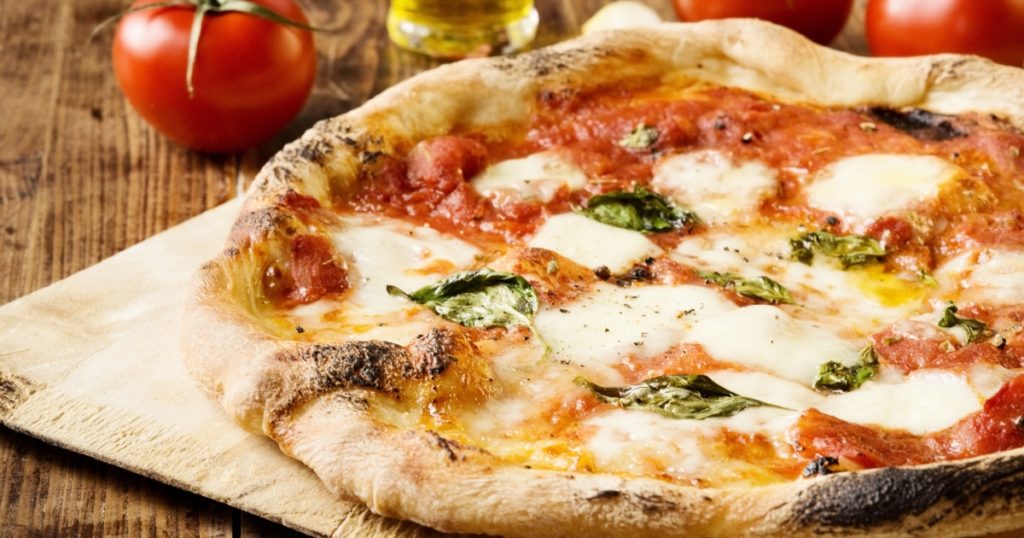
A Neapolitan pizza takes the classic Margherita to the next level with extra sauce and cheese. This pizza comes from Naples, Italy, and is famous for its thin, tender crust. It’s usually covered with San Marzano tomatoes, fresh mozzarella, basil, salt, and a drizzle of extra-virgin olive oil.
This pizza is baked in a wood-fired oven at high heat. The result is a beautifully blistered crust and a deliciously smoky taste.
According to Pizza Bien, a pizza can only be considered a true Margherita if it meets four main criteria, as outlined by the Associazione Verace Pizza Napoletana:
- You may use only San Marzano tomatoes.
- You can use only fresh mozzarella. The mozzarella must be made from water buffalo milk or a mix of cow and water buffalo milk. This specific type of milk is chosen for the rich, creamy texture and taste it imparts to the cheese.
- The dough must be expertly prepared using only flour, yeast, salt, and occasionally sugar and beer.
- The pizza must be cooked in a wood-fired oven at approximately 900 degrees Fahrenheit. It is a process that takes just 60 to 90 seconds.
These strict guidelines ensure the preservation of the authentic Neapolitan pizza’s traditional essence.
Different Kinds of Pizzas to Make 5: Chicago Deep Dish Pizza
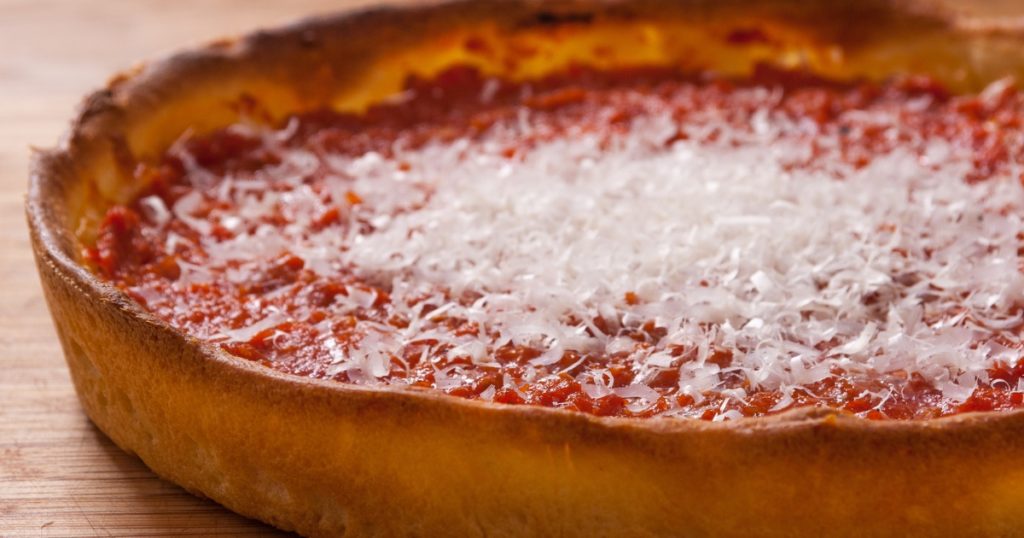
Out of the different types of deep dish pizza, Chicago Deep Dish pizza is one of the most well-known ones.
Originating in Chicago in 1943, It features a thick, buttery crust that lines a deep pan, creating a deep dish. The pizza is assembled with toppings such as Italian sausage, onion, peppers, and mushrooms, followed by a layer of fresh mozzarella cheese and chunky tomato sauce. Due to its thickness, Chicago deep pizza requires a longer baking time in the oven.
This style of pizza has become synonymous with Chicago and is celebrated for its hearty and indulgent nature. Oh, and this pizza’s indulgent nature and meaty flavors demand the use of a knife and fork for a better dining experience. We’d definitely call it one of the best dinner ideas (or lunch)!
Different Kinds of Pizzas to Make 6: California Pizza
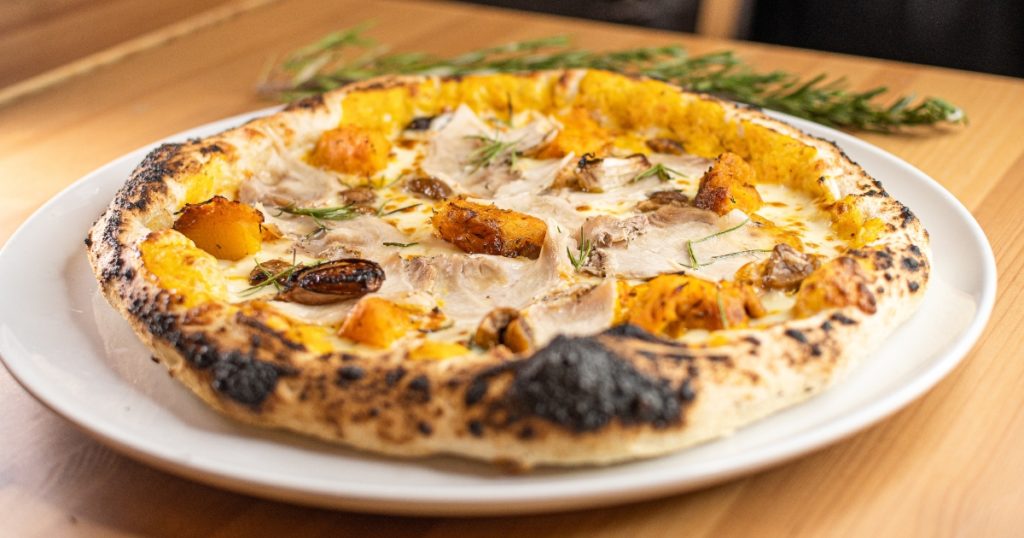
California pizza is a style of pizza that originated in California, United States. It blends influences from New York and Italian thin-crust pizzas with toppings inspired by California cuisine. Adventurous eaters will love its creative pizza toppings such as barbecue sauce, bbq chicken, avocado, sun-dried tomatoes, and goat cheese. Some makers even add spinach, artichoke hearts, and peanut sauce.
It is often baked in a wood-fired oven or on a pizza stone. It can be served with either thin and crispy pizza crusts or thicker and chewier ones.
Different Kinds of Pizzas to Make 7: New York-Style Pizza
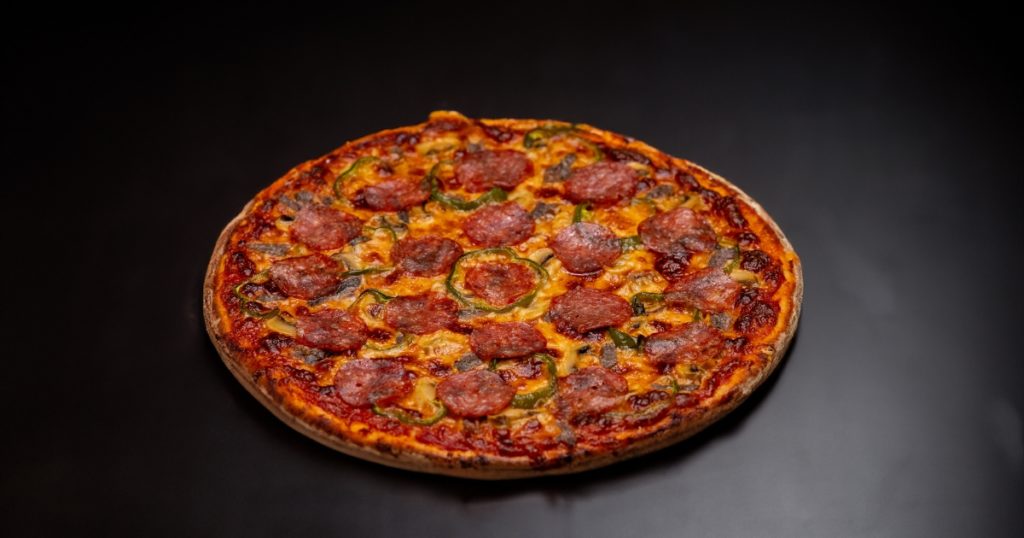
New York-style pizza is all about big, foldable slices with a thin, slightly chewy crust. Pizza makers toss it by hand and top it with tomato sauce and stretchy, low-moisture mozzarella. You can jazz it up with extras like pepperoni, mushrooms, or sausage. Baked in a gas oven, it gets a perfectly crispy yet bendy crust.
This pizza came to life when Italian immigrants hit New York City in the early 1900s. The dough’s made with high-gluten flour, a bit of sugar, olive oil, yeast, and water, giving it a unique taste and texture. The sauce? It’s a seasoned mix of tomatoes, garlic, and herbs, slathered over the crust before adding cheese and other toppings. And if you like, sprinkle on some garlic powder, red pepper, oregano, or Parmesan after baking.
Different Kinds of Pizzas to Make 8: Mushroom Pizza
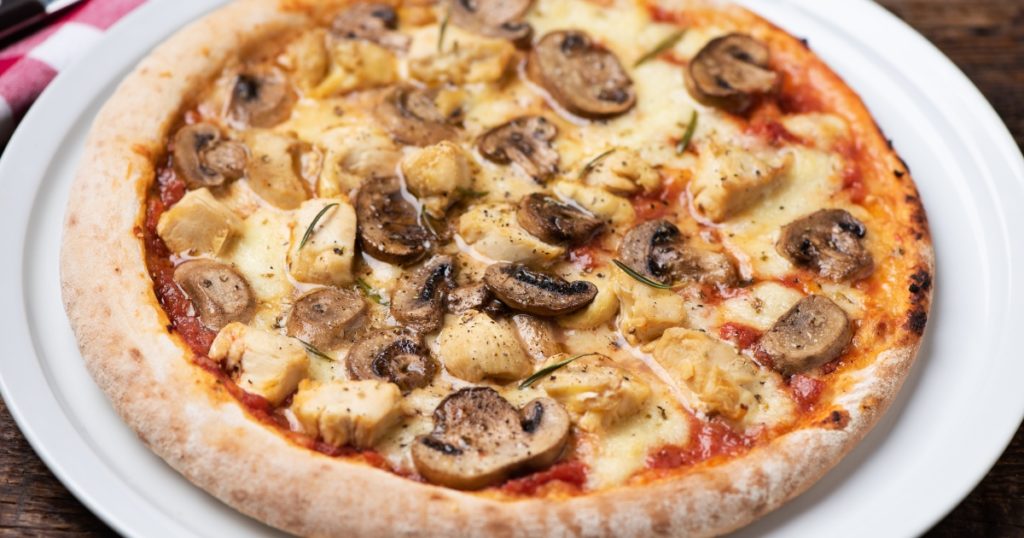
Mushroom pizza is a classic choice for pizza lovers who are looking for vegetarian recipes. It’s simple: a thin or thick crust topped with tomato sauce, lots of mozzarella cheese, and heaps of mushrooms. Whether you like your mushrooms sautéed first or thrown on fresh, they add a juicy, earthy flavor to the pizza that’s hard to beat.
This pizza is perfect for those who love a bit of nature’s bounty on their plate. You can stick to just mushrooms or mix in other toppings like onions, peppers, or different cheeses to make it your own. Bake it until the cheese is bubbly and golden, and you’ve got a delicious mushroom pizza ready to enjoy!
Which type of pizza is the most popular?
It’s hard to say which type of pizza is the most popular because everyone has their own favorite. With so many kinds of pizzas out there, from classic cheese and pepperoni to more unique flavors like Alfredo Pizza or Buffalo Chicken Pizza, it really depends on personal taste.
Some people love the simplicity of a Margherita, while others prefer the variety of a supreme pizza—and some even love pizzas with black olives. In the end, it really depends on who you ask. Everyone has their own favorite when it comes to eating pizza, that’s for sure!
Want to learn the different types of pizza to make at home?
Finished reading and feeling inspired for a pizza night at home? Why settle for delivery when you can craft your own perfect pizza, ensuring top-notch quality every time? That’s why homemade pizza is better—it’s simply unbeatable.
But where can you get recipe collections for homemade pizza? Well, you don’t have to go far. Just enroll in Chef Joey Prats’ newest class here at The Bailiwick Academy: Pizza Master Class Deluxe!
Enroll and get hands-on with these eight pizza styles:
- Cast Iron Pan Pizza
- Chicago Style Deep Dish
- Detroit Style Pizza
- New York Style Pizza
- Roman Style Pizza Bianca
- Sicilian Style Stuffed Crust with Vodka Sauce
- California Style BBQ Chicken Pizza
- Neapolitan Style Pizza
Just like all the classes at The Bailiwick Academy, it’s an easy-to-follow class, perfect even if you’re a beginner. You’ll not only learn to make these diverse pizzas but also gain skills that go beyond the basics. This class is your ticket to making the perfect pizza every night.
Soon enough, you’ll be on your way to starting a food business. Maybe it will even be one where you transport your baked pizza pie to your customers.
What are you waiting for? Sign up at The Bailiwick Academy today and start your journey to being one of the best pizzaiolos ever!
—
Keep coming back to The Bailiwick Academy blog for more cooking and baking tips, kitchen tricks, and much more!
]]>I hope you get inspired by them!
Why Catering Is A Big Opportunity in 2024
2024 is shaping up to be a great year for starting a catering business. What makes me say this, you ask?
- There are already projections of more business meetings and corporate events this year. And if you remember one of my tips for standing out as a catering business, it’s to close plenty of corporate clients. 2024 makes it super possible to succeed in catering.
- There are always weddings here in the Philippines. For example, according to the Philippine Statistics Authority (PSA), the number of people who got married increased from 2019 to 2022. I’m pretty sure the same thing happened in 2023, and will happen in 2024!
- And of course, Filipinos love to party and celebrate special occasions such as baptisms or birthdays. And with celebrations always come food, which means more catering opportunities success—and income!
Those three are more than enough reasons, wouldn’t you agree?
How To Really Succeed In Catering
Are you now really, REALLY encouraged to try your hand at catering this 2024? I hope so, especially if you’ve been dreaming of coming up with a cooking and baking empire for a long time already!
Now, how exactly do you go about it? Sure, I gave you seven tips to get started on a catering business… but I feel like the best way to really find out is to check out some of the best caterers in the Philippines!
I did a quick search, found this list, and this list, and found some commonalities of what makes them great, according to the lists:
- Delicious food of different cuisines
- Great service
- Beautiful setups
- An overall amazing experience
But here’s the thing: knowing what makes a great caterer and actually implementing these things are two different sides of the coin.
Besides, even if you know, how can you be sure that you can apply the knowledge and actually achieve catering greatness?
Well, that’s where Catering 101 of The Bailiwick Academy comes in!
Succeed in Catering in 2024 With Catering 101
Our Catering 101 course is like a training camp for caterers, perfect for enthusiastic home cooks like you.
You’ll pick up skills to make your catering business really stand out. This includes learning effective marketing, creating a memorable menu, and setting the right prices to ensure good profits.
We’ll show you how to smoothly handle tough situations and demanding customers. Plus, you’ll learn ways to make such a great impression that your customers will be eager to return.
This course is filled with tips and tricks from some of the Philippines’ top caterers and chefs.
By the end of it, you’ll be ready to handle big events, lead a great team, and have the know-how to expand your catering business.
Who will be teaching Catering 101?
We were on the lookout for caterers who could help us make this class really comprehensive… and we’re lucky that we already have onboard Chef Him Uy De Baron!
Chef Him is hailed as one of the biggest names in the culinary world, Chef Him runs various restaurants all over the Philippines and is one of the instructors inside The Bailiwick Academy since 2022.
Check out the preview of this class here:
But it’s not just Chef Him. Meet the others:
- Beejay Tantoco, who runs his family catering business Tantoco’s Catering (established in 1994) where they close government accounts, serve celebrities, and entered popular food markets like Mercato and Bancheto.
- Chef Kalel Chan, a corporate chef of Raintree Restaurants which operates 10 restaurants — Farmer’s table, Saboten, Cha Cha’s Boracay, The Coconut Club, Izakaya Sensu, My Country House, Jones All Day, and so much more. He’s famous for The Original Ube Champorado!
- Aileen Ferrer, a Bailiwicker, our community manager of the TBA Student Lounge, and a businesswoman who runs “Unwrapped – Flowers, Hampers and Events” — a flourishing floral and event styling company that works with corporate clients, weddings, and various events.
- Michelle Lazaro, another Bailiwicker who runs Balai Calamba, a catering business based in Laguna. She also owns two commercial kitchens strategically located in Las Piñas and Laguna. She has catered for corporate events of Hyundai, Chery, and Foton.
- We also have a mystery chef! He has been in the food business for almost 20 years. His experience includes working for Nestle as a Regional Chef Consultant, running a Catering Business since 2004, and starting a new food business last 2022. You’ll find out who he is when you join the program!
How Catering 101 Will Go
Catering 101 starts on January 28, 2024, and will be broken up into six strategic modules to help you succeed in catering.
Week 1: Laying the Foundations For a Successful Catering Success
This week, you’ll dive into the essentials of starting a catering business. This includes understanding the market, the diverse roles in catering, and what initial capital you’ll need. You’ll also learn about building a strong team, crucial for a successful operation.
- Discover the catering market opportunities, especially in the Philippine context.
- Learn directly from industry experts about starting a catering business, covering everything from capital needs to logistics.
- Understand the various roles you’ll play, from chef to business strategist.
- Get a detailed breakdown of initial capital requirements for budget planning.
- Learn how to assemble a strong team, including roles like event managers and chefs.
- Gain real-world insights from successful caterers on launching and growing your business in the Philippines.
- Balance your passion for food with the skills needed for running a successful business.
Week #2: Crafting a Unique Brand that Makes Sales and Marketing Simple
Week 2 focuses on branding, sales, and marketing in the catering industry. You’ll learn how to differentiate your business in a competitive market and make an impact.
- Understand the different catering types and their unique needs.
- Learn how to evaluate your competition and identify your unique selling points.
- Gain insights from real-life examples on effective brand positioning.
- Learn how to engage potential clients with compelling sales pitches.
- Create a targeted marketing plan and schedule.
- Learn the steps for testing your business concept before a full-scale launch.
- Understand the importance of maintaining good relationships in corporate catering.
Week #3: Create Irresistible Menus and Aesthetically-Pleasing Meals Like a Catering Pro
In Week 3, you’ll delve into menu planning and food presentation, learning how to create menus that are both delicious and practical for catering.
- Explore various menu styles and learn how to select the best for different events.
- Learn recipe selection that’s both tasty and catering-friendly.
- Understand the challenges of catering food, including logistics and quality maintenance.
- Acquire skills in food presentation to enhance event dining experiences.
- Learn essential food safety practices.
- Manage supplies effectively and build strong supplier relationships.
- Get advice on setting up an efficient off-site kitchen.
Week #4: Costing and Pricing Best Practices to Maximize Profits
This week is all about the financial side of catering, focusing on recipe costing, pricing strategies, and understanding overhead costs.
- Learn to cost recipes accurately and understand their financial impact.
- Develop effective pricing strategies that reflect your service’s value.
- Understand the overhead costs involved in catering.
- Design profitable and appealing menus.
- Develop financial management skills for long-term success.
- Balance cost-effectiveness with high-quality offerings.
- Adapt pricing strategies to market dynamics and customer expectations.
Week #5: Master the Essentials of Booking, Service, and Crisis Management
The fifth week covers the practical aspects of managing catering events, from booking to service standards and crisis management.
- Learn the comprehensive process of booking events.
- Master creating a BEO for outlining event details.
- Develop a culture of excellent service in your team.
- Handle crises and difficult clients professionally.
- Follow up with clients post-event for feedback and repeat business.
- Use successful events as marketing tools while respecting client privacy.
Week #6: The Essentials of Table Styling for Every Occasion
In the final week, you’ll learn the art of table styling, ensuring your setups are as memorable as your food.
- Learn to set up buffet and dining tables for various events.
- Choose the right serving and dinnerware to enhance the dining experience.
- Discover flower arrangement tips for stunning table displays.
- Customize table setups for different themes.
- Receive step-by-step instructions for flawless table presentations.
By the end of these six weeks, you’ll have a comprehensive understanding of starting and running a successful catering business, equipped with practical skills and insider knowledge!
How To Enroll In Catering 101
It’s easy! All you have to do is sign up at The Bailiwick Academy then go over to the Catering 101 Page. Enroll, and then make sure to block off January 28, 2024, as that’s the first day of class!
Final Thoughts About How To Succeed in Catering in 2024
Looking ahead to 2024, it’s clear that there’s a big chance for success in the catering business. With more companies holding events, lots of weddings, and Filipinos loving big celebrations, there’s plenty of work for caterers.
To really do well in catering, you need to mix your love for cooking with smart business skills. That’s where our Catering 101 course at The Bailiwick Academy comes in. It teaches you everything from understanding what customers want to making your catering stand out, to handling money matters.
You’ll learn from experts like Chef Him Uy De Baron, who know all about making great food and running a successful business. They’ll share their secrets on how to make your catering unforgettable and how to handle any tough situations that come up.
Don’t miss this opportunity to turn your passion into a profitable venture! Become one of the Bailiwickers trained by successful food business owners on how to launch a catering business in 2024.
Join Catering 101 today. See you inside!
—
Keep coming back to The Bailiwick Academy blog for more baking and cooking tips, kitchen tricks, and much more!
]]>Keep on reading as I walk you through these key processes to get your home-based catering business off the ground.
1st Step For Starting A Catering Business: Conduct Thorough Market Research
The first step in starting your catering business is to really get to know your market. This includes doing the following:
- Figuring out who would want your catering services and what kind of food they like. Are people in your area into fancy wedding banquets, or do they prefer casual birthday parties, or is there a demand for vegan and/or gluten-free menus?
- Think about the prices people are willing to pay and what times of the year get really busy with events. This part of the job might involve some online research, talking to people, and maybe even checking out different types of events to see what’s popular. Getting this step right sets you up to create a business that really fits into your community and stands out from the competition.
Understanding what people around you want and what other catering businesses are offering (or not offering) can help you find your own special spot in the catering world.
What happens if you skip market research?
Not doing market research when you start your catering business is like trying to hit a target while blindfolded. This means you might make a menu that doesn’t fit what people in your area are looking for. For example, you could end up offering fancy, expensive dishes in a place where people prefer simple, affordable food, or the other way around.
Also, you might set your prices too high and scare customers away, or too low and not make enough money. Plus, you could miss out on finding a special service or dish that nobody else is offering to any potential client. In short, skipping market research can lead to making bad choices for your business, wasting time and money, and having a hard time getting and keeping customers.
2nd Step For Starting A Catering Business: Develop a Solid Business Plan
After you’ve got a good handle on the market, the next big step is to make a solid business plan. Make sure it includes the following:
- How much you’ll charge for your services, who you want to cater to (like weddings, parties, or corporate events), and how you’ll let people know about your business.
- How much it’ll cost to start your business, keep it running, and make a profit.
Having a clear business plan helps you stay focused and organized. Plus, if you ever need to make business loans or get investors, it’s ideal to have a plan that shows how making an investment in you is a good idea!
What if you start running your business without a plan?
Sure, you can start your catering business without a plan, but there’s a good chance things won’t turn out right. Without a business plan, you might experience these:
- Spending money too fast
- Finding yourself in situations where you’re not prepared, like a big event that you don’t have enough staff or supplies for.
- A hard time tracking goals and progress—you might not know if you’re making enough money to cover your costs or if you’re charging the right prices.
In short, without a plan as a basis or something to fall back on, you’re going to make things riskier and stressful for yourself.
3rd Step For Starting A Catering Business: Get the Necessary Licensing and Permits
This particular step is important because you want to be a legitimate and legal business entity, even if you’re just operating out of your own kitchen space. That means making sure you have all the right licenses and permits. Depending on where you live, you’ll need different kinds of permits, like a food handler’s license, a health department permit, and maybe a general business license.
Getting these licenses might seem like a lot of paperwork and maybe a bit of a hassle, especially when you just want to start a catering business in the Philippines, but trust me. It’s worth it for your own peace of mind and for customers to trust that they’re eating food that’s safe and prepared in a clean environment.
What are the consequences of skipping this step?
If you don’t go through the proper steps and channels, you could get into legal trouble, which can mean fines or even having to shut down your business. Additionally, operating without the necessary permits can damage your reputation. If word gets out that you’re not properly licensed, it can be really hard to build trust with potential clients and make it difficult for your catering operation to grow and succeed.
4th Step For Starting A Catering Business: Create a Memorable Brand and Marketing Strategy
A good marketing strategy gets your name out there and brings in customers. Do the following to accomplish this:
- Think about what makes your cooking or your service special and use that to build your brand.
- Your brand is what makes you different from all the other catering companies out there, so make sure it’s memorable—come up with a catchy name, a logo, and even a unique color scheme.
- Don’t just stop at having a brand—you need to let people know about it via a marketing strategy. You can use social media, like Facebook or Instagram, to show off your food and tell people about your services.
- You could also make a website, hand out flyers at events, or team up with local event planners.
What if you don’t take the time to make a brand and strategize your marketing?
If you don’t invest time in building your brand or your marketing strategy, you’ll struggle to stand out in the competitive catering industry, making it hard to attract and retain customers. Without a way to spread the word about your services, many potential clients won’t even know your business exists. This lack of visibility can lead to fewer bookings and limited growth opportunities.
5th Step For Starting A Catering Business: Plan Your Menu Carefully
Since you are running a food business, it’s super important to think about what types of food you’re going to offer. Here are some things to keep in mind.
- Your menu is like your business card—it shows off what you can do. Make sure it has a good mix of different kinds of dishes so you can please all sorts of customers.
- As mentioned above, include things for people who might be vegetarian, or who don’t eat gluten, so everyone has something they can enjoy.
- Think about how much the ingredients cost and how long each dish takes to make. You want a menu that’s not just tasty but also doesn’t cost too much to make or take too long to prepare.
Can’t I just offer whatever food people look for?
There’s always the temptation to offer a wide range of foods that people are looking for, but it’s not always the best idea. Why?
- If you try to make too many different kinds of food, you might need lots of different ingredients and a lot of time to prepare everything. You’ll end up overexerting yourself which can affect the quality of your service and your food.
- As Chef Joey Prats says in this feature, it’s better to focus on a few things. This way, you can make sure the quality is always top-notch, and you won’t get overwhelmed. Plus, having a speciality can make your catering business stand out from others.
6th Step For Starting A Catering Business: Invest in Quality Equipment and Supplies
The sixth step is to make sure you have the right tools and supplies for your catering operations. This means:
- Getting things like reliable stoves, sharp knives, and sturdy pots, pans, and chafing dishes.
- Think about what you need for serving the food, like trays, dishes, and utensils.
- Note that it’s worth spending a bit more on these because they’ll help you cook better and faster, and they’ll last longer.
- Find some trustworthy suppliers who can give you fresh and high-quality ingredients. Having good supplies means your food will taste better, and that’s what will make your customers happy.
Can’t I save up by just spending on less-than-quality equipment?
You might think you’re saving money upfront by buying cheaper, lower-quality equipment, but it can actually cost you more in the long run:
- Low-quality equipment often breaks down more easily and doesn’t perform as well.
- You might end up with food that’s not cooked properly or you could face delays in your service as your business grows.
- This can disappoint your customers and hurt your business’s reputation.
- You’ll also likely have to replace or repair cheap equipment more often, which adds up over time.
Investing in good-quality equipment is a smarter move because it’s more reliable, lasts longer, and helps you maintain a high standard of service.
7th Step For Starting A Catering Business: Hire and Train a Skilled Team
If you want your catering business to last, you’ll have to admit to yourself that you’ll need a team. Even if you’re great at cooking, you can’t do everything alone, especially as more orders come in. You’ll need chefs, servers, and maybe even a person to help with cleaning or deliveries.
Look for people who are not only good at their jobs but also friendly and professional because they represent your business. Once you’ve got your team, it’s important to train them well. Make sure they know how to prepare and serve food the way you want, and that they understand the importance of customer service.
Is hiring and training a team really necessary?
Like I said earlier, you can’t do everything yourself. A well-trained team can make a huge difference in how smoothly your events go and how happy your customers are. They can help you handle bigger jobs and make sure everything runs on time.
Plus, having a team allows you to focus on the parts of the business where you excel, like creating menus or networking with clients, while they handle the day-to-day tasks. It also means you can take on more events and grow your business faster.
Final Thoughts
Starting a catering business, especially from home, is an exciting journey filled with opportunities and challenges. But by following these seven steps, you’ll be well on your way to launching a successful catering business in 2024.
Of course, I’d want to help make you even more successful. That’s why you should watch for my next blog post, where I’ll talk about simple hacks to get more business and referrals as a startup catering business. These tips will be invaluable in expanding your client base and enhancing your brand’s reach.
Stay tuned! And while you’re here, don’t forget to sign up at The Bailiwick Academy to access courses that will inspire and expand your future catering menu options!
—
Keep coming back to The Bailiwick Academy blog for more baking and cooking tips, kitchen tricks, and much more!
Not to worry—that’s what this article is for! Let’s explore some popular types of chocolate and see how they can affect your baking and make your treats even more delicious.
How do you make chocolate, anyway?
Making this ingredient called chocolate is a long process that begins far before the local chocolate shop or grocery store. Yup, you don’t just manufacture a chocolate bar and then sell it in stores. It’s a lot more complicated than that!
To make chocolate, you actually start with the seeds of the Theobroma cacao tree, also known as cacao beans. The beans from the tree are dried, roasted, and then ground, resulting in two products: cocoa butter, a smooth, solid, white fat; and what is called chocolate liquor, or ground cocoa beans.
The variety in chocolate mainly depends on how much cocoa butter and chocolate liquor it has compared to sugar, milk solids, and other things mixed in.
Types of Chocolate
On to the main section of this article! Here are some popular kinds of chocolate.
Milk Chocolate

Milk chocolate is a beloved kind of chocolate that you can enjoy for its smooth, creamy texture and sweet, mellow flavor. You can make this type of chocolate by combining cocoa solids with cocoa butter, sugar, and, as the name suggests, milk, either in liquid, powder, or condensed form. The presence of milk gives it a lighter color and a softer texture compared to its darker counterparts.
Typically, milk chocolate contains about 10% to 40% cocoa mixed with a higher proportion of sugar, which makes it much sweeter and less bitter than dark chocolate. Its mild and sweet profile makes it a popular choice for snacking, candy bars (like those covered in this article), and baking, appealing to a wide range of palates, especially those who prefer a less intense chocolate experience. Milk chocolate’s versatility and delightful taste make it a staple in the world of confections and desserts.
White Chocolate

White chocolate stands out in the chocolate family for its, well, white color. Aside from that, white chocolate doesn’t contain cocoa solids – the element that gives chocolate its usual brown color and rich taste. Instead, it’s made primarily from cocoa butter, which is the fat extracted from cocoa beans, combined with sugar and milk solids. This unique blend results in a creamy, ivory-colored chocolate with a smooth, velvety texture.
White chocolate’s flavor is sweet and rich-when you taste it, you might describe it as having a delicate, buttery profile with hints of vanilla. It lacks the bitterness associated with cocoa solids, making it a favorite for those who prefer a sweeter and less intense chocolate taste. The minimum cocoa butter content in white chocolate is usually about 20%, contributing to its melt-in-the-mouth quality.
White chocolate’s mellow and sweet character makes it a popular choice for ganaches, frostings, and as a coating for truffles and candies. Its ability to pair well with a variety of flavors, from fruits to nuts, also makes it a valuable ingredient for creating different kinds of desserts, even avant-garde ones. For those who enjoy experimenting in the kitchen, white chocolate offers a delightful canvas for culinary creativity.
Dark Chocolate

Dark chocolate is different from milk or white chocolate because it has more cocoa and less sugar. This gives it a darker color and gives it a bold, intense flavor. Dark chocolate is made with cocoa solids, cocoa butter, and a small amount of sugar, but usually doesn’t have much or any milk.
The amount of cocoa in dark chocolate can be anywhere from 30% to over 80%, meaning it is less sweet chocolate. However, people still like it because they consider it to be healthier and full of antioxidants. It’s great for baking things like rich cakes and desserts like chocolate brownies, and it goes well with lots of flavors, like fruits and nuts, especially if you’re looking for a flavor profile with a really chocolatey taste.
Unsweetened Chocolate

Unsweetened chocolate, also referred to as baking chocolate, is a pure form of chocolate used in cooking and baking. It’s made entirely from ground cocoa beans, resulting in a product that contains 100% cocoa solids without any added sugar. This gives this chocolate bar a very strong and bitter taste, making it unsuitable for eating on its own but ideal for recipes where other ingredients add the necessary sweetness.
You can use unsweetened chocolate as a base in recipes, combined with sugar and other ingredients to create a balanced flavor profile. Since it provides a deep, rich chocolate flavor to chocolate cakes, brownies, and other desserts and doesn’t have sugar, it allows bakers to control the level of sweetness in their creations. Its versatility makes it a must-have for anyone who loves to bake and experiment with chocolate recipes.
Cocoa Powder

Cocoa powder is a key ingredient in many baking recipes, known for its rich flavor and versatility. You make it by grinding cocoa beans and removing most of the cocoa butter, leaving a fine powder. This process results in a product that’s almost 100% pure cocoa content, giving it a strong, bitter chocolate flavor.
Because it’s unsweetened and has a low fat content, cocoa powder is perfect for adding a deep chocolate flavor to baked goods like cakes, cookies, and brownies without making them too heavy. It’s You can also use it in other recipes like hot chocolate, chocolate sauces, and even some savory dishes for a touch of richness. Cocoa powder also easily mixes into batters and doughs.
Couverture Chocolate

Couverture chocolate is a high-quality chocolate that is a favorite among professional chocolatiers and pastry chefs. What sets it apart is its high cocoa butter content, typically ranging from 32% to 39%, which gives it a superior ability to coat and mold into shapes with a smooth, glossy finish. This high percentage of cocoa butter, combined with proper tempering, ensures that couverture chocolate melts evenly and has a satisfying snap when broken.
This kind of chocolate comes in dark, milk, and white chocolate varieties, offering versatility in flavor and application. It’s also Ideal for making fine chocolates, truffles, and chocolate decorations, especially since couverture chocolate has a rich flavor and creamy texture. Whether it’s for dipping, coating, or as a base for ganaches, couverture chocolate provides a luxurious taste and professional-quality results, making it a must-have for anyone serious about chocolate crafting.
Want a taste of using this type of chocolate? Try out Chef Ely Salar’s The Art of Chocolate class.
Ruby Chocolate

Ruby chocolate is a relatively new and unique addition to the chocolate world, known for its striking pink color and distinct flavor. Introduced in 2017, chocolatiers make this from specially selected ruby cocoa beans, which naturally have a pink hue. This type of chocolate stands out not just for its color but also for its complex flavors, which you can describe as a unique taste of white chocolate and berries, without the addition of any berries or fruit flavors.
Unlike traditional chocolates, ruby chocolate offers a tart yet sweet experience, making it a popular choice for innovative confectionery creations. It’s particularly appealing for its aesthetic value in desserts and chocolates, offering a visually stunning alternative to the classic chocolate varieties. Ruby chocolate’s unique flavor profile and eye-catching appearance make it a favorite among chefs and food enthusiasts looking to experiment with new and trendy ingredients in their culinary creations.
And of course, these would look super appealing if, say, you made a gift basket, especially during the holiday season or special occasions. Your eye-popping chocolate gifts would be the talk of everyone.
Which type of chocolate is the most popular?
It’s hard to say which type of chocolate is the most popular because everyone has their own favorite. It’s the same as answering how many types of chocolate are there. Why?
For instance, some people might say milk chocolate is the most popular type because it’s sweet and creamy. Plenty of companies and chefs also use milk chocolate in candy bars and desserts.
Then there’s dark chocolate, which has been getting more popular lately, especially with adults who want something less sweet and maybe a bit healthier, as mentioned above. White chocolate is also popular in its own way. It’s really sweet and doesn’t taste much like regular chocolate, but lots of people like it for its creamy flavor.
In short, it really depends on who you ask. Everyone has their own favorite when it comes to eating chocolate for sure!
Want the types of making artistic chocolate explained?
Now that the different types of chocolate that are popular have been explained to you, what’s the next step? Well, you might want the opportunity to explore the delightful world of chocolate making.
If yes, The Bailiwick Academy has you covered! Introducing Chef Miko Aspiras’ latest class, Festive Chocolate Confections!
In this class, you’ll learn how to make amazing chocolate treats. We’ll show you how to make cool Chocolate Blocks of different flavors, fancy Chocolate Lollipop Webs, and really special Matcha Nama Chocolate. You’ll work with different kinds of chocolate like milk, dark, and white, and learn how to turn them into beautiful chocolate pieces.
These chocolates won’t just look good or be great as sweet treats; they can also be good for your business if you’re thinking of selling them!
So, are you ready to start creating awesome chocolate creations? Sign up at The Bailiwick Academy and start your chocolate-making adventure today!
—
Keep coming back to The Bailiwick Academy blog for more baking and cooking tips, kitchen tricks, and much more!
]]>Not to worry! If you’re curious about this iconic dessert, you’ll be happy to hear that this article will dive into the world of fruit cakes and discover why it has become synonymous with a Christmas menu.
Let’s get started, shall we?
So…what is a fruit cake?
What are fruit cakes, indeed? At its core, a fruit cake is a rich, dense cake packed with dried or candied fruits, nuts, and spices. The ingredients are often soaked in spirits like brandy or rum, which not only adds a depth of flavor but also acts as a preservative.
The cake is typically made well in advance of Christmas, allowing it to mature and develop its complex flavors. A fruit cake can also come in different shapes. It can be a round cake or be presented as mini loaf cakes, depending on the cake pan used. Mini loaves are easier to serve—something to note if you’re having a lot of guests who love fruits and cake in one dish!
Where is fruit cake from?
The origin of fruit cake can be traced back to ancient Rome, where a simple version was made using barley mash, pomegranate seeds, raisins, honeyed wine, and pine nuts. This early version was more of an energy-rich food than a celebratory treat. Since it was easy to carry around and didn’t rot for a long time, it became a very popular snack for Roman soldiers, who called it “satura.”
During the Middle Ages, with the arrival of preserved fruits, honey, and spices, the fruit cake began to resemble what we know today. The Crusaders reportedly carried this durable, energy-packed cake on their journeys for the same reason as the Roman soldiers did: due to its long shelf life. The bakers at the time also added more fruit and nuts.
Fruit cakes were eventually brought to America by European colonists and became especially popular in areas with limited access to fresh fruit. And now, here we are: a world where fruit cake is looked for during Christmas and other special occasions, like weddings.
Why This Dessert Is Associated With Christmas
This is actually a pretty interesting fact in the history of fruit cake. In the 18th century, laws were passed to restrict the creation of the fruit cake (called as a plum cake back then) in Europe, as the cakes were considered as “sinfully rich.” They were only allowed to be created during the holiday season, especially since the ingredients to make this at the time were considered both rare and expensive.
So, it makes sense that fruit cakes became a special treat for big occasions, right? Especially for Christmas. But why exactly fruit cakes became a Christmas thing is a bit of a mystery. They were first made as a high-energy snack, not really for celebrations.
One interesting story is from Swiss Colony. They say that in England, people used to give fruit cakes to Christmas carolers, who were often not very rich. This might be one reason why fruit cakes got so popular for Christmas.
What are the ingredients in a fruit cake?
Fruit cake is known for its diverse ingredients, which can vary based on personal preference, the cake recipes being used, or regional traditions. However, the usual fruit cake recipe includes the following components:
- Dried Fruits: This is the heart of the fruit cake. Common choices include raisins, currants, sultanas, dried cherries, apricots, and cranberries. Any candied fruit like orange and lemon peel are also popular.
- Nuts: Almonds, walnuts, pecans, and hazelnuts are often added for crunch and flavor.
- Flour: Standard all-purpose flour is typically used as the base for the cake.
- Sugar: White or brown sugar is used to sweeten the cake. Brown sugar can give a deeper flavor and moistness.
- Eggs: Eggs are essential for binding the ingredients together and adding richness.
- Butter: Unsalted butter—not margarine—is commonly used for its flavor and for adding moisture to the cake.
- Spices: A mix of spices like cinnamon, nutmeg, allspice, and cloves adds warmth and depth.
- Leavening Agents: Baking powder or baking soda helps the cake rise.
- Liquor: Brandy, rum, or whisky is often used to soak the fruits and to brush on the cake for preservation and flavor. Non-alcoholic versions might use fruit juices like orange juice or apple juice.
- Extras: Ingredients like molasses, honey, or treacle can be added for extra flavor and color. Vanilla or almond extract are also common for enhancing the aroma.
The great thing about fruit cake is that it is highly customizable. You can adjust the types and quantities of fruits and nuts to suit your taste, and even play around with the spices and flavorings. The key is to balance the flavors and textures to create a cake that’s something you really like.
What is the shelf life of a fruit cake?
A fruitcake that is tightly wrapped with aluminum foil or plastic wrap can be stored for up to 1 month in a cool, dark pantry, 6 months in the refrigerator, and 12 months in a freezer. Some people even feel that older fruit cakes taste better because of the alcoholic content. Of course, if there are signs of spoilage such as mold or off-odors, make sure to discard it!
But why does fruit cake last long, exactly? Well, one reason is thanks to its high alcoholic content. Alcohol acts as a natural preservative which prevents spoilage.
As for the other factors, well, it’s the same answer for the question why is a fruit cake dry. Its high sugar content helps absorb moisture, reducing the risk of bacterial growth. The dried fruits in the cake have low water content, further inhibiting spoilage. The cake’s dense texture, achieved through slow baking at low temperatures, also helps in preserving it.
Interestingly, the same things that make fruit cake last a long time have also made it a bit of a joke. Its heavy texture and strong flavor, plus the fact that it seems to never go bad, have made people joke about it as a holiday gift that nobody really wants and keeps getting passed around. But even with this funny reputation, many people still love fruit cake for its special taste and its place in holiday traditions.
Tips For Making Your Fruit Cake At Home
Want to have a fruit cake for the Christmas season? Sure, you can buy, as there will be plenty for sale this time. But if you want to make one yourself so you can control the ingredients, appearance, taste, and so on (i.e. you saw a recipe you wanted to try), here are some tips to take note of:
- Start Early: Begin your fruit cake preparations early. The longer the fruits soak and the cake matures, the better the flavor.
- Customize Your Cake: Feel free to experiment with different fruits, nuts, and spices. Make your fruit cake a reflection of your taste.
- Low and Slow: Bake your cake at a low temperature for several hours. This ensures even cooking and a moist texture.
- Storage: Wrap the cake in alcohol-soaked cheesecloth, then in foil. Store it in a cool, dark place and periodically brush it with more alcohol.
Make A Truly Delicious Fruit Cake With The Bailiwick Academy!
As we mentioned, you might have a fruit cake recipe you want to try. Well, here at The Bailiwick Academy, we have a class that you should definitely try. What are we talking about?
We’re talking about Chef Joey Prats’ Opulence Unwrapped: The Holiday Cake Experience class!
In this class, you’ll learn to make a unique fruitcake that everyone can enjoy, even kids! Chef Joey has crafted a recipe that’s both traditional and fresh, perfect for the holiday season. You’ll get to experiment with different fruits, nuts, and even choose your preferred alcohol, or opt for a non-alcoholic version.
His course is packed with easy-to-follow video tutorials, professional baking tips, and a fool-proof recipe. Whether you’re baking for your family or thinking of selling, this class has you covered.
This class is a must-add to your recipe collections. So what are you waiting for? Sign up at The Bailiwick Academy and start your journey to making the perfect holiday cake—bring the joy of fruitcake into your home this Christmas!
—
Keep coming back to The Bailiwick Academy blog for more baking and cooking tips, kitchen tricks, and much more!
]]>Keep reading for reasons I’m sure you will be able to relate to, especially if you’re a fellow mom.
A Brief History of Fried Chicken
Before we answer why do I like fried chicken so much, let’s take a quick look at where fried chicken came from. According to The Cookful, this beloved dish has two origin stories. One is that it came from the Scottish who decided to start deep frying chicken while the rest of the world was still just baking or broiling it—and that’s how it came to America eventually via Scottish immigrants.
The other story is that it came from West Africa, since the people there already have a tradition of frying food in hot oil. It was because of slavery that fried food made its way to America. Despite this particular origin being tied to a shameful period of American history, fried chicken has evolved into a widely enjoyed dish, and its popularity continues to endure.
Whatever the real story, fried chicken came to America, and continued to grow in popularity until it pretty much conquered the world! Think about it: can you name any common restaurant or convenience store that doesn’t have fried chicken in its menu?
I didn’t think so!
Reasons Why I Love Fried Chicken
Now, going back, why do I love chicken so much? Well, I’ve thought about it pretty well, and ultimately, it boils down to seven reasons.
Reason 1: It’s Super Easy To Make
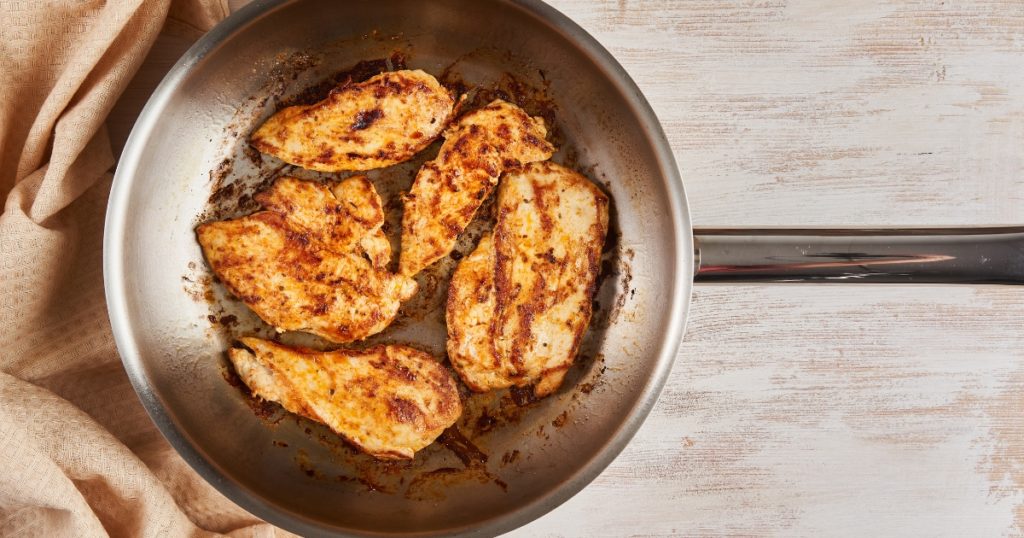
Fried chicken is the ultimate go-to for us busy moms. In fact, because it’s pretty fast and convenient to make, it’s a lifesaver!
Think about it; you can:
- Marinate chicken pieces with simple pantry staples like soy sauce, calamansi, and a bit of garlic, then use a pan or airfryer to achieve crispiness in an hour or less; or
- Get some already breaded chicken from the grocery, pop it in the oven toaster, wait, and eat fried chicken!
In short, fried chicken is always there to save the day, especially on those lunches or dinners when you can’t really think of what to cook.
Reason 2: Fried Chicken Is Easy To Access
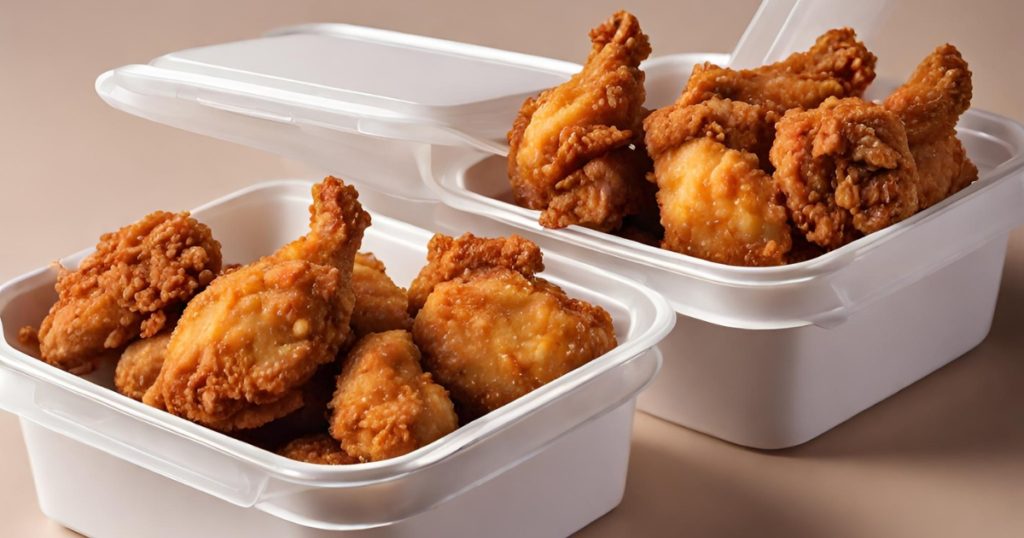
Fried chicken is practically everywhere here in the Philippines. Even street vendors have their own version. There’s just something about the taste of this deep fried goodness, I guess.
And that’s the great thing: it’s so common, you can get it anytime, anywhere, whether you’re at home and not wanting to cook, or on the road, and you’re looking for some delicious food. Admit it: you already have favorite fried chicken spots, such as one that has a secret mix of herbs and spices which makes it finger lickin’ good!
Reason 3: Practically Everyone Loves Fried Chicken

Who can resist fried chicken? No one, that’s for sure! Even the pickiest of eaters can’t resist this particular fried food. It’s the one dish that will bring smiles to everyone at the table.
Reason 4: Science Backs Me Up!

Did you know that even science explains why fried chicken tastes are irresistible? It’s all about the chemistry of fried food, also known as the Maillard reaction. It gives fried chicken the tempting golden color and mouth-watering flavor. This reaction creates a variety of flavor compounds, making each bite a complex taste experience.
But there’s more: the texture! The contrast between the crunchy outside and the juicy inside is scientifically proven to delight our taste buds. Studies show that this texture contrast not only pleases our palate but also makes us crave more. So, when we’re enjoying that crispy, juicy chicken, we’re actually delighting in a culinary marvel of science—cool, huh?
Reason 5: Fried Chicken Is Comfort Food

There’s an undeniable comfort in a good piece of fried chicken—there’s warmth and satisfaction that comes with every bite. The symbolism of fried chicken is a taste of home, no matter where you are.
And if you think about it, fried chicken is so delicious, but there’s more! Each crunchy bite reminds us of festive family celebrations, lazy Sunday lunches, and those impromptu gatherings that turn into cherished memories. It’s more than just food; it’s a comforting embrace, a reminder of happy times, and a simple pleasure that connects us to our loved ones and our roots.
Reason 6: It Goes With Everything
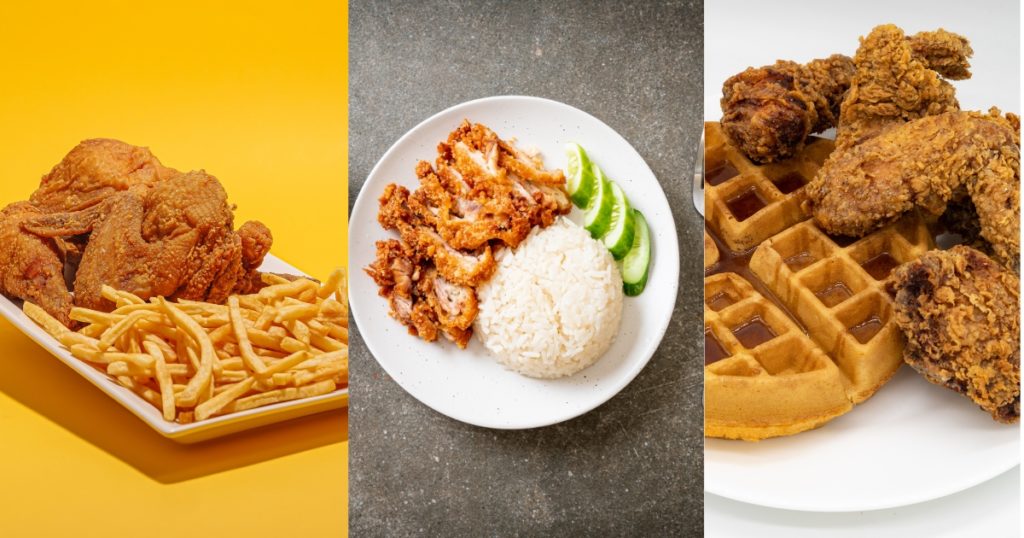
One of the best things about fried chicken is its incredible versatility. Whether it’s paired with rice, crispy fries, waffles, or if you want to use it as the meat for your sandwich, chicken just simply goes with everything!
Fried chicken also even fits into all kinds of meal settings. It’s a hit at a fancy dinner party, just as much as it is during a summer barbecue. No matter the occasion or the time of day, fried chicken is always welcome to the table.
Reason 7: Fried Chicken Is Very Versatile
Why do I love fried chicken? One more reason is it’s because it’s very versatile! You can enjoy the classic chicken taste, or go spicy, sweet, sour, and more. It’s always fun to play around and create your version of this beloved dish.
Let’s not forget the endless possibilities of flavors and marinades. You can go from a simple garlic and soy sauce marinade to a more adventurous coconut milk and lemongrass blend. The possibilities are endless!
Final Thoughts
So there you have it, my fellow Filipino moms! Fried chicken is more than just a dish; it’s a part of our culture, a comforting presence in our lives, and a reason to come together and celebrate. Here’s to more crispy, juicy, delightful moments – one piece at a time!
Love fried chicken? You’ll love this class!
As passionate about fried chicken as I am? Want to experience delicious fried chicken with those commercial tastes you love? Want to take your food business to the next level?
Well, you can do all that with the latest class here at The Bailiwick Academy by Chef Anthony Ang: Fry ‘Em Up: Pinoy Style-Fried Chicken!
This isn’t just any cooking class. It’s a golden opportunity to recreate the iconic flavors of famous Filipino fast-food fried chicken. Imagine mastering the art of making Whole Fried Chicken, Classic Chinese-style fried Chicken, and the crowd-pleaser, Famous Fast Food Fried Chicken—all of them tasting like some of those commercial chickens you love, or even better!
There’s a bonus too! You’ll learn the secret behind making super delicious garlic fried rice that pairs perfectly with these crispy delights.
Whether you’re a home cook looking to wow your family or an aspiring entrepreneur ready to cater to your clients’ discerning tastes, this class might be the one you’re looking for. Don’t miss out on this finger-licking opportunity—sign up at The Bailiwick Academy today and enroll in this class to elevate your fried chicken game!
—
Keep coming back to The Bailiwick Academy blog for more baking and cooking tips, kitchen tricks, and much more!
]]>Why make and give edible Christmas gifts?
Christmas food gifts are a thoughtful, inclusive, and delicious way to create lasting holiday memories and spread cheer. By investing time and care into baking or creating a culinary treat, you showcase your skills and creativity, making each gift a unique expression of affection. These gifts are delightful to receive, won’t contribute to clutter, and can be customized to suit individual tastes and dietary needs.
Convinced? Great! Now, if you’re wondering, “What can I make as Christmas gifts?”, well, we’ve got you!
On to the seven ideas!
Edible Christmas Gift Ideas To Make 1: Homemade Cookies

Homemade cookies are a timeless and delightful choice as one of your choices for Christmas gift ideas. You can make different flavors and styles that will suit everyone’s taste. It doesn’t have to be holiday-themed either, like gingerbread men or cookies shaped into candy canes—classic cookie shapes and flavors like chocolate chip cookies will do.
But if you want to keep with the season, pack them in decorative tins or cellophane bags tied with festive ribbons. And there, you have an easy, DIY gift of Christmas cookies!
Thinking of what cookies to make? Choose from these classes here at The Bailiwick Academy: Gourmet Cookies by Chef Bam Piencenaves, Best Ever Cookies by Chef Joey Prats, and Unique Cookie Concepts by Chef Miko Aspiras.
Edible Christmas Gift Ideas To Make 2: Polvoron In A Jar
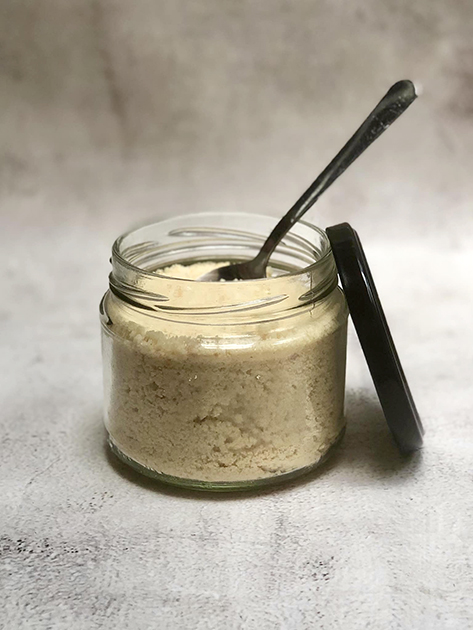
Polvoron traditionally is eaten molded into shapes, but why not give your loved ones something different? For this holiday season, surprise your loved ones with a creative twist on this classic delicacy by presenting the polvoron powder in mason jars. You can add a spoon so that they can eat out of the jar, but you can also attach instructions on how to mix and mold the polvoron, turning these edible gifts into a cute, delightful activity.
Looking for the best polvoron recipe possible? Check out Chef Miko Aspiras’ Madrid Fusiòn Polvoron class.
Edible Christmas Gift Ideas To Make 3: Cakes In Cans

Cakes in cans are a fun and unique edible gift idea for Christmas. Simply bake your favorite cake dessert recipes in a clean, empty can, and you’ve got a portable and delightful item great for Christmas gifting. You have the freedom to choose any cake recipe you like, from chocolate fudge to white chocolate to fruitcake.
Once baked and cooled, you can decorate the can with ribbons or stickers and add a little note to make it personal. This DIY gift is not only tasty but also shows your creative side.
Want to give these as gifts during the festive season? Check out Chef Joey Prats’ The Cake Cannery class or Ms. Chiqui Ortiz-Dingcong’s Keto Cheesecakes class for sugar-free, guilt-free options.
Edible Christmas Gift Ideas To Make 4: Pie

Homemade pie is a heartwarming gift that brings comfort and joy during the holiday season. Whether it’s a classic apple pie or every Pinoy’s favorite pasalubong, buko pie, it’s sure to be a hit. Bake it in a disposable pie tin, let it cool, and then wrap it up with some festive wrapping or place it in a pie box.
Add a little tag with a sweet message or the recipe, and your delicious, thoughtful food gifts are ready to go!
Looking for an easy recipe to make pies? Check out Chef Jimbo de Panadero’s Bakery-Style Buko Pie class or Chef Joey Prats’ Fabulous Pies class.
Edible Christmas Gift Ideas To Make 5: Savory Treats In Jars

Not everyone has a sweet tooth, and that’s where savory treats in jars come in handy. You can layer ingredients for a soup mix, create a homemade spice blend, or even jar up some chili oil, marinated olives or feta. These edible Christmas gifts in a jar are not only tasty but also show that you’ve put thought into catering to different tastes.
It’s definitely a great way to introduce friends and family to new flavors and recipes—and are great for business way after the holiday season.
To get more specific, you can:
- Enroll in Gourmet in a Bottle by Chef Chona Garcia-Laureta for some long-lasting, gourmet fish treats;
- Get Chef Allan Mertola’s recipe for Chili Garlic Sauce in his Dimsum 101 class, which we’ve heard are best-sellers for plenty of Bailiwickers; or
- Take Chef RV Manabat’s All-Natural Meat Processing class and learn his recipe for preservative-free Garlic Atsara, which, as we all know, is enjoyed by many Pinoys!
Edible Christmas Gift Ideas To Make 6: Christmas Ham

A Christmas ham is already a popular Christmas gift idea here in the Philippines, so why not make your own for a really perfect gift? You can be sure that receivers will appreciate this homemade edible gift, especially during family dinners for the holiday season.
And if you want to make some of the best hams ever, enroll in Sir Rodney Martinez’ Delicious Glazed Hams class. Make two kinds of hams and glazes that will take your loved ones’ ham experience to the next level!
Edible Christmas Gift Ideas To Make 7: Chocolate Truffles

Chocolate truffles are luxurious and decadent homemade Christmas gifts, perfect for those who appreciate the finer things in life. You can make them at home using good quality chocolate, cream, and a bit of butter, then roll them in cocoa powder, chopped nuts, or coconut flakes. Place them in a small box or cellophane bag tied with a ribbon, and you have an elegant gift ready to go.
And believe us, when you give these as gifts for friends, they will love you for life! After all, chocolate truffles are not just a gift; they’re an experience, rich and full of flavor. When you taste your creation, this homemade gift might not make it to your loved ones—they’re that good!
Speaking Of Chocolate Truffles…
If you’re on the hunt for a treat that’s both easy to make and irresistibly delicious, you’ve hit the jackpot! Check out Chef Chona Garcia Laureta’s class: Chocolate Cookie Truffles!
Enroll in this class and get an easy recipe for no-bake Chocolate Cookie Truffles! Imagine biting into a glossy chocolate shell and finding a velvety, melt-in-your-mouth center – that’s exactly what these truffles offer. They’ll strike the perfect balance between simplicity and indulgence, and are suitable for any occasion, making them a versatile gift option, not just during the holidays.
Ready to dive in? Sign up at The Bailiwick Academy today to start making these homemade food gifts! They’re simple but decadently delicious treats that are sure to impress!
Final Thoughts
We hope you found one you want to try from this list of edible Christmas gift ideas to make! This holiday season, let your loved ones know just how much you care with thoughtful, homemade gifts. From sweet to savory, there’s a delightful option for everyone.
Get creative, personalize your gifts, and embrace the joy of giving. Happy holidays!
—
Keep coming back to The Bailiwick Academy blog for more baking and cooking tips, kitchen tricks, and much more!
]]>Oh, and good news: you won’t have to look for a French bakery or take a trip to France to taste. You can already find some classic French pastries in bakeries in the Philippines. And others?
Well, you can make them right in the comfort of your home, thanks to the courses here at The Bailiwick Academy!
On to the list!
Croissant
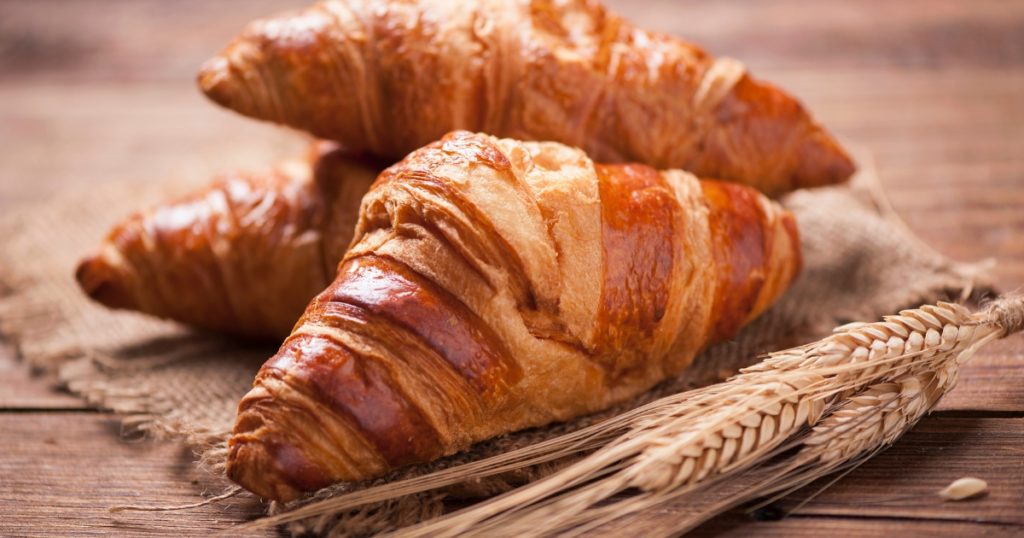
Ah, the iconic croissant! These crescent-shaped, flaky wonders are a staple of French bakeries worldwide. Made with layers of buttery dough, the perfect croissant boasts a crisp exterior and a soft, airy interior.
Whether they’re plain or filled with chocolate, almonds, or ham and cheese, the croissant is a must-try for any pastry connoisseur.
Is this one of your favorite French pastries? Easily make them at home with our Laminated Dough class by Chef Jimbo de Panadero!
Éclair

Éclairs are the epitome of pastry elegance. These long and thin choux pastry delights are filled with luscious cream and glazed with glossy icing. Chocolate éclairs are the most famous, but flavors like coffee, pistachio, and raspberry offer a delightful twist on tradition.
No matter the flavor, éclairs are a must-try! You can Google “French pastries near me” to look for the nearest bakery… or just enroll in our Making The Perfect Cream Puffs and Eclairs class! Aside from learning how to make éclairs, you’ll get Chef Jimbo de Pandero’s process for making the perfect cream puff—an added dessert!
Macaron

First things first—macarons are different from macaroons. Macaroons are coconut-based cookies. On the other hand, French macarons are small, colorful, and delicate almond meringue cookies that sandwich a creamy filling. They come in different flavors, from classic vanilla to exotic lavender, and melt in your mouth.
With their delicate shells and creamy fillings, macarons are a symphony of textures and tastes. Be sure to savor each bite slowly to fully appreciate their charm. But if you can’t (which is totally understandable), just enroll in Chef Joey Prats’ Parisian Macarons class. That way, you can easily make more when you finish your stash of this classic French dessert.
Madeleine
Madeleines are small, sponge cake-like pastries that look like shells. Typically flavored with lemon zest and vanilla, madeleines are a sweet and light treat, perfect with tea or coffee.
These may be petite, but the impact of these French food is out of this world: the French novelist Marcel Proust immortalized the madeleine in literature for its ability to evoke powerful memories.
Mille-Feuille

You can also call the mille-feuille a Napoleon pastry. All of us non-French speakers are thankful for this. It’s easier to pronounce, after all!
Going back, the mille-feuille is composed of puff pastry layers and rich pastry cream. The top layer is usually garnished with powdered sugar or icing, sometimes detailed with intricate designs. Each bite offers a satisfying crunch followed by a velvety, creamy center.
In short, it’s the perfect balance of textures and flavors that makes this pastry a must-try.
Pain au Chocolat

This rectangular pastry is similar to a croissant, but there’s a twist: it contains a delicious chocolate ganache that can ooze out with each bite! The contrast between the flaky pastry and the gooey chocolate is sheer bliss, and can easily make this your favorite French dessert!
Opera Cake
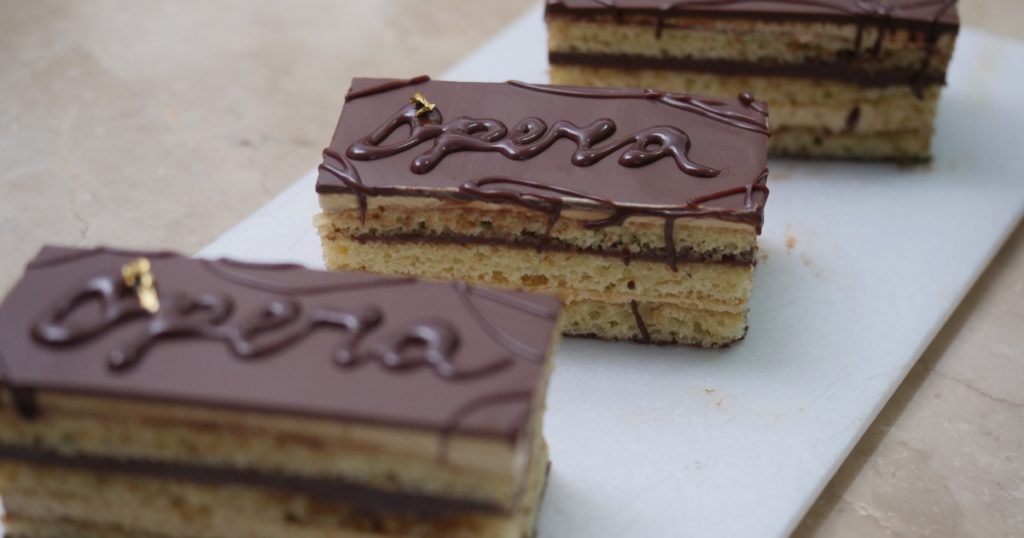
We’ve talked about opera cake before; it’s a French dessert that’s known for its richness and elegance. People call it an opera cake because it resembles the structure of an opera house. Isn’t it amazing how its layers of almond sponge cake soaked in coffee syrup, layered with ganache and coffee buttercream and covered in a chocolate glaze look so good?
And if you want to experience this famous French dessert for yourself, you can enroll in Chef Ely Salar’s Opera Gateaux class! No need to go to a bakery in Paris for this—pretty cool, huh?
Croquembouche

We’re sure you’ve seen one of these at grand celebrations, and they’re appropriate for taking center stage! This towering masterpiece consists of profiteroles, or cream puffs, stacked high and bound together with spun sugar. It’s a showstopper at weddings and special occasions, and breaking off a golden puff is a joyous experience.
They’re great alternatives to tall cakes, actually. Add them to your food business by enrolling in Chef Miko Aspiras’ Croquembouche class! Isn’t it nice, another to add to your list of French pastries to make at home?
Kouign-Amann
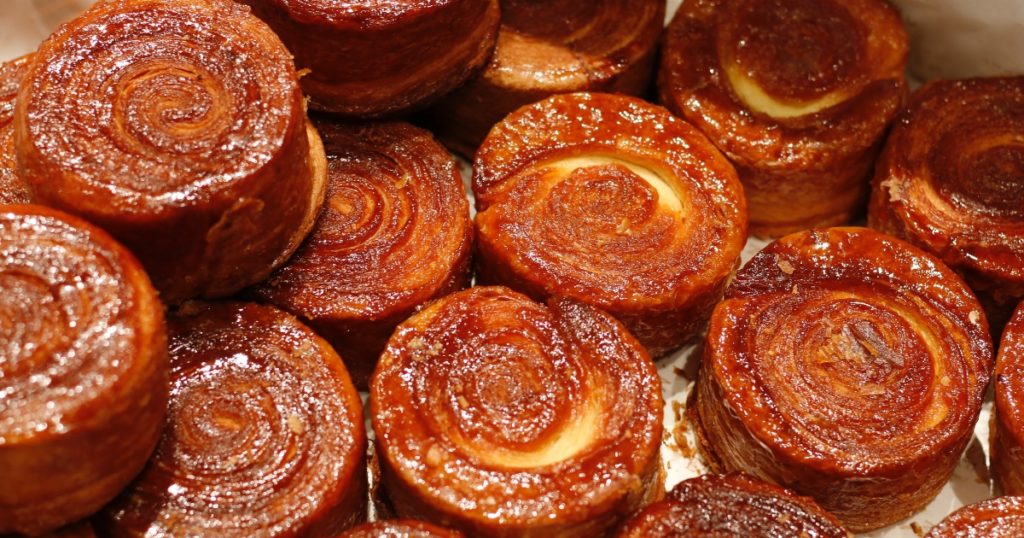
The first thing that came to mind when we encountered this was how you pronounce it? (Spoiler: kween uh·man).
The second? Well, what is this item from the French patisserie?
Well, Kouign-Amann is a pastry from the Brittany region of France. It is notable for its layered composition, similar to plenty of puff pastries, but made with bread dough, butter, and sugar. It gets its distinctive taste from a blend of sweetness and saltiness and is highlighted by a rich buttery flavor.
The multiple layers, achieved through meticulous folding and layering by masterful French pastry chefs, create a crispy, caramelized exterior and a tender, sweet interior, offering a unique combination of textures and flavors.
While it may not have the international recognition of croissants or macarons, Kouign-Amann has experienced a rise in popularity, captivating palates with its decadent richness. You can enjoy it best when it’s fresh from the oven and paired with coffee or tea.
French Tarts
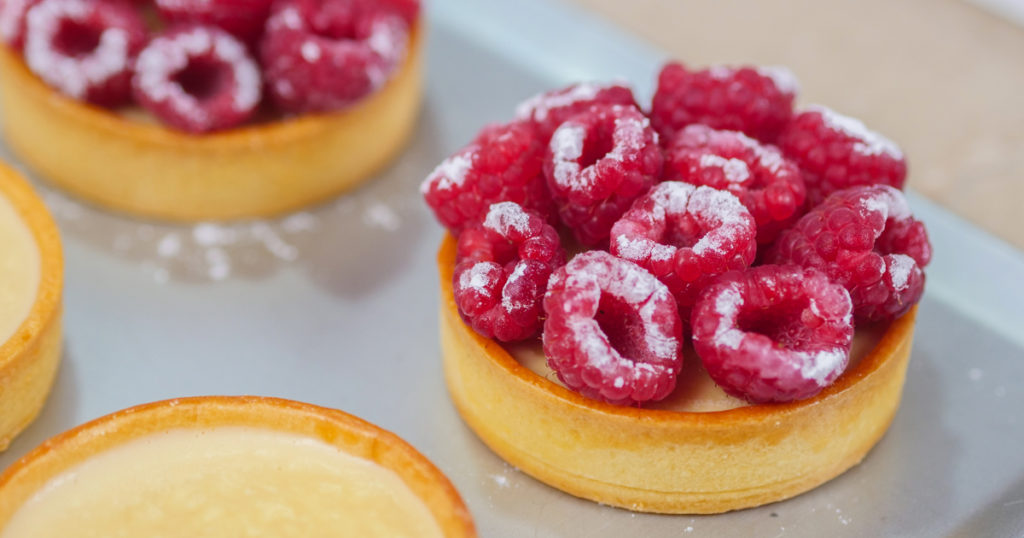
French tarts are an artful combination of crisp pastry crusts and vibrant fruit fillings. Some of the varieties are Tarte aux Fruits, which features a medley of fresh berries or citrus slices, and Tarte au Citron, a flavor that delivers a zesty, lemony punch. No matter what you’re looking for, every palate has a French tart.
Speaking of French Tarts…
Want to try your hand at making these popular French pastries? You’re in luck: Chef Ely Salar has a new class called French Tarts!
These French Tarts are true masterpieces, ready to steal the spotlight on any occasion, especially with Chef Ely’s own special twists for pastry recipes. You can make French tarts that aren’t just fruit fillings, such as Pistachio Crème Brûlée and Tsokolate Salted Caramel. Of course, the classic fruit tarts won’t disappear with the Pecan Tart, Mango Cream Cheese, and Raspberry and Strawberry Tarts.
All are vibrant, filled with luscious pastry cream and a delectably sweet pastry crust. They’ll be sensory delights for your eyes and taste buds. And with this class, you’ll know the answer to the question, “Are French pastries difficult to make at home?”: not with The Bailiwick Academy!
Sign up at The Bailiwick Academy now to start making these French pastries that are a must-try! You’ll feel like a master French pastry chef in no time!
Final Thoughts On French Pastries To Try
Exploring French pastries is like embarking on a sweet, delectable journey through culinary art. Each pastry has a unique texture, flavor, and appearance, reflecting the rich culinary heritage of France. So the next time you’re in a French bakery, be sure to indulge in these French pastries to try to experience a taste of culinary luxury.
And, of course, sign up at The Bailiwick Academy to make various French pastries at home that are also must-tries. See you in one of our classes!
—
Keep coming back to The Bailiwick Academy blog for more kitchen and baking tips, tricks, and much more!
]]>Yes, all creams are made from milk fat—yes, another use for milk aside from pouring into your coffee or enhancing your cereal. And yes, all cream can make food taste richer and creamier, and all kinds are called cream. But knowing about different creams is important because it lets you choose the right one for your recipe, helping you get the best taste and texture and avoid wasting food and money.
In this article, I’ll help you do exactly that. Join me as I take a different look at different types of cream available for your use, each with its own texture, fat content, and use. You’ll find out how each one can make your culinary creations better!
Note: This article was originally written last March 18, 2018. This has been updated on September 24, 2023.
How are different types of cream made?
As mentioned above, cream is derived from milk, making any type of cream a dairy product. When fresh milk is left to stand, a layer of cream rises to the top, and this cream is then skimmed off. In modern dairies, this process is expedited using centrifuges called separators.
Do take note that the above is a general overview since different creams require different processes. For example, some commercial creams undergo ultra-pasteurization for longer shelf lives, while some creams are homogenized to ensure a uniform texture and prevent the fat from separating.
The cream obtained after the process can be of varying fat contents, which are then categorized into different types of cream.
Now we get to the heart of the article: what ARE the different types of cream?
Heavy Cream
Heavy cream, also known as whipping cream or heavy whipping cream, has more fat compared to other creams, with at least 36% fat. This makes it great for whipping as it holds its shape well. It’s often used to add richness to desserts, toppings, and fillings because of its creamy texture and taste—but because it’s so rich, it can form lumps more easily than lighter creams.
TL;DR:
- Fat Content: Typically 36-40%
- Uses: Whipping cream is beloved for making whipped cream for desserts as well as custards, ice cream, sour cream, crème fraîche, and rich soups. Its high-fat content makes it whip up beautifully and can hold its shape—perfect for cake icing or frosting.
- Trivia: Heavy cream whipping results in a doubling of its volume!
Clotted Cream
If you haven’t heard of clotted cream, it’s perfectly normal! After all, it’s in England where it’s more common, usually for their scones and jams. If you thought heavy cream had high-fat content already, clotted cream has the most, with about 55-65%!
Clotted cream has an appearance similar to the whipped butter you might have with pancakes in restaurants—thick and rich. You can use clotted cream in sauces or fudge for a richer texture or spread on top of different desserts.
Want to try making it for yourself and, well, trying it out? You can, but you’ll need plenty of time and patience. Get heavy cream and cook it slowly in the oven to make the water evaporate and leave fat behind.
Take note that it takes about a day to make and cool it. It’s safe to keep for a whole week in the fridge.
TL;DR:
- Fat Content: 55-60%
- Uses: A thick, rich cream with a golden crust on top. It’s a common treat in England, particularly enjoyed with scones and jam.
- Trivia: The cream is “clotted” by heating it slowly in shallow pans.
Crème Fraîche
France is a source of many delicious things to indulge in, such as baguettes, opera cakes, and crème fraîch. Crème fraîch is a French cream with good bacteria, making it thick and taste nutty. While it’s similar to sour cream in some ways, it’s not as sour, so it’s great for baking.
You can use it for topping sweet foods such as cobblers or fruit pies—its unique taste adds another layer of flavor to the sweet fruits. You can even add crème fraîch to your mashed potatoes, soups, or stews for an added tang.
TL;DR:
- Fat Content: Around 30-40%
- Uses: This tangy, thickened cream does not curdle at high temperatures, making it perfect for sauces and soups. It’s also delightful on desserts.
- Trivia: It originates from France, and its name literally translates to “fresh cream.”
Light Cream
Light cream has less fat compared to other creams, about 18% to 30% fat. Because it has a lower fat content, it doesn’t whip well, so it’s not ideal for topping desserts. If you plan to use light cream in hot sauces or soups, it’s not the best cream since it might separate due to the heat.
However, light cream is great to add to coffee or drinks for added texture and even flavor. That’s probably why light cream is known as coffee cream or table cream. Light cream also works well in recipes if you want a subtle cream flavor without overpowering the other ingredients.
TL;DR:
- Fat Content: Between 18% and 30%.
- Uses: Commonly used to enrich the flavor of coffees and teas and suitable in recipes that don’t require whipping.
- Trivia: Even though it’s called “light,” it’s still thicker than half-and-half and plain milk!
Double Cream
Double cream is a type of cream made by using a special machine to separate the fat from the milk. As a result, double cream is thicker and richer than heavy cream but with a bit less fat than whipping cream. Speaking of whipping, double cream is great for it but be careful not to overdo it, or it will become butter. It’s perfect for making sauces or risotto thicker and creamier; it has so much fat it won’t curdle easily.
TL;DR:
- Fat Content: About 48%
- Uses: It’s so thick it can be spooned out, making it great for topping various desserts. It can also be whipped, although it thickens rapidly and can become butter.
- Trivia: Double cream can be used to make clotted cream.
Single Cream
I know what you’re thinking: if there’s a double cream available, then there must be a single cream also, right? Well, you got that correctly! Single cream is a cream containing around 20% milk fat or even less and is similar to light cream or half-and-half.
Single cream is very versatile; you can pour it over desserts, add it to coffee or tea, and even use it to make sauces and soups smoother and more flavorful without making it too rich or heavy.
TL;DR:
- Fat Content: Around 18%
- Uses: Perfect to pour over desserts or add to coffee.
- Trivia: It’s too light to whip but adds a creamy touch to dishes and beverages.
All-Purpose Cream
Since it’s the start of the Ber months by the time of this writing, you’re probably going to see plenty of all-purpose cream being stocked in groceries and local stores. Hey, it’s an important ingredient for the usual Pinoy Christmas food, right? But what exactly is all-purpose cream?
Well, as the name implies, it’s a versatile type of cream that is suitable for both cooking and whipping. This cream can be used in a variety of dishes like soups, sauces, desserts, and beverages to add richness, creaminess, and flavor. It usually has a fat content around 18-36%, making it a middle-ground option between light cream and heavy cream.
In short, it’s a handy option to have in your pantry as it can fulfill the roles of different types of cream, saving you from having to buy different kinds of products.
TL;DR:
- Fat Content: Varies, typically around 18-36%
- Uses: Known for its versatility, it can be used in cooking, baking, and dessert-making. Used as a thickening component for fruit salads or the milk component for soups, stews and sauces. It’s also great for pastries and more.
- Trivia: It is processed to have a stable consistency, making it suitable for various culinary applications.
Whipping Cream
Whipping cream and heavy cream are often confused due to their similarities, but they do have some differences. The former has less fat, and while it whips well, it won’t form as stiff peaks as heavy cream would. It’s commonly used in making desserts like whipped cream and mousses and is also handy in soups, sauces, and gravies.
Be careful not to mix up whipping cream with the canned whipped topping found in the frozen aisle, as this is a different product made from a cream substitute and is not ideal for baking or cooking if you’re aiming for the best flavors.
In essence, aside from the slight variations in texture and fat content, whipping cream and heavy cream can generally be used interchangeably, explaining why the terms are often used interchangeably.
TL;DR:
- Fat Content: Around 30-35%
- Uses: Use this to make whipped cream for topping pies, cakes, and other sweet treats. It’s also good for making a creamy frosting for cupcakes and cakes. You can also add it to soups and sauces for extra creaminess.
- Trivia: Some people interchange this with heavy cream, but they are different from one another. If you whip this too much, just like double cream, it can become butter.
Half-and-Half
You might have first heard about half-and-half at Starbucks; I know I did! It’s a favorite for coffee enthusiasts and often has a spot reserved in their fridges. Half-and-half is made by mixing equal parts of milk and cream and has less fat, around 10.5 to 18%.
Aside from it being a popular choice for coffee lovers, you can use it in various recipes such as clam chowder and creamy pasta dishes. However, you can’t use it to make whipping creams since it doesn’t have enough fat.
TL;DR:
- Fat Content: 10-18% (usually made from half milk and half cream)
- Uses: A popular coffee creamer in the U.S., but is also be used in cooking and baking when a lighter cream is preferred.
- Trivia: You can’t whip half-and-half on its own, but if it’s all you have and you’re in a pinch, you can add a little melted butter to increase the fat content and whip it up.
Sour Cream
Sour cream is a tangy and creamy dairy product made by fermenting regular cream with lactic acid bacteria and has around 20% milk fat. It is a staple for many cuisines and is used in dips, dressings, and as a topping for savory dishes like baked potatoes and tacos. However, sour cream is also a baking ingredient—you can use it to add moisture and tenderness to your baked goods for a more delicious experience.
Remember to keep it cool to avoid it going bad. Here’s an added trick: store your sour cream container upside down in the fridge to reduce the space for bacteria to grow!
TL;DR:
- Fat Content: Around 20%
- Uses: Made by fermenting regular cream with certain kinds of lactic acid bacteria. It’s a staple in many dishes, from dips to baked goods to toppings.
- Trivia: Did you know that sour cream is often used in baking to produce a moist crumb in cakes?
Quick Tips On Using Different Types Of Cream
As you may have noticed, creams come in different thicknesses and fat content, and each one is good for different kinds of dishes. Some are best for pouring, others for whipping, and some can do it all! Here are some easy tips to help you figure out which cream to use:
- When choosing a type of cream, consider the fat content as well s the desired flavor and texture of your dish. This is because the fat in the cream can change the taste and feel of your dish.
- Heavy and whipping cream products are best for whipping and for making dishes that require a rich and creamy texture because they have more fat. More fat means they can get thicker when you whip them, and they can make foods taste richer and creamier.
- Light cream and half-and-half are good for adding creaminess to soups, sauces, and gravies. This is because they can mix well with other liquids and add a nice creamy taste without making the dish too thick or heavy.
- Sour cream and crème fraîche add creaminess and a tart flavor to dishes. Since they are thick and have a sour taste, they add creaminess and a little zing to make your culinary creation taste more interesting and feel smoother.
- Clotted cream is good for adding creaminess and a rich flavor to desserts.
Conclusion
Cream is a delicious and versatile ingredient that can be used to enhance the flavor and texture of many different dishes. With so many different types of cream available, there is sure to be a type of cream that is perfect for your recipe.
I hope the next time you reach for that carton in the refrigerator or supermarket aisle, you’ll know what you’ll get with your cooking and baking creations. Happy, er, creaming!
Oh, and of course, before I go, if you want the chance to try different types of cream for different kinds of dishes, whether sweet or savory, sign up at The Bailiwick Academy! With over a hundred courses, you can learn how to use different creams in your cooking and baking and find out how to make yummy dishes and treats that everyone will love.
See you in one of our classes!
—
Keep coming back to The Bailiwick Academy blog for more kitchen and baking tips, tricks, and much more!